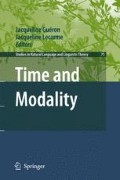Abstract
This chapter examines the syntax and semantics of the English Konjunktiv II (K2) construction. Use of the K2 is restricted to an informal register of English; it is replaced by the past perfect in the standard, more formal, register. It occurs only in a subset of the syntactic environments in which the past perfect occurs, however, and is associated with a strongly counterfactual interpretation (primarily counterfactual conditionals and complements to wish-class verbs). Morpho-syntactically, K2 resembles the past perfect, insofar as it contains the preterit form of the auxiliary have (namely, had) followed by the past participle. K2 differs from the past perfect, however, in that an additional particle occurs between had and the past participle; this particle is phonologically a weak enclitic attached to had, and has been analyzed variously as a reduced form of the auxiliary verb have (– ’ve) or as a preposition (of) or particle (a); thus the past perfect form had gone corresponds to the K2 had’ve gone or had of gone. I analyze K2 syntactically as a subjunctive perfect form, where subjunctive mood is conveyed by the preterit affix –ed, and the perfect functions as a past polarity item signaling the presence of a covert past tense. The type of subjunctive mood that occurs in the K2 is distinct from the mandative subjunctive mood that occurs in the complements of demand/ask class verbs. Both types of subjunctive are licensed strictly locally, in contrast to the subjunctive mood licensed by negation in languages such as French. I suggest that this is related to the modal force of the subjunctive in these contexts. The particle of/have in the K2 is a subjunctive polarity item, disambiguating the subjunctive perfect from the indicative past perfect.
Access this chapter
Tax calculation will be finalised at checkout
Purchases are for personal use only
Preview
Unable to display preview. Download preview PDF.
References
Abusch, Dorit (1988). Sequence of tense, intensionality and scope. WCCFL 7, Stanford University.
Hoffman, T. Ronald (1966). Past Tense Replacement and the Modal System. In A. Oettinger (ed.), Mathematical Linguistics and Automatic Translation. Harvard University, Harvard Computational Laboratory, Cambridge, MA, VII-1-21. Reprinted in McCawley (1976), Notes from the Linguistic Underground. (Syntax and Semantics, 7.) New York: Academic, pp. 85-100.
Iatridou, Sabine (2000). The Grammatical Ingredients of Counterfactuality. Linguistic Inquiry 31, 231-270.
Ippolito, Michela (2003). Presuppositions and Implicatures in Counterfactuals. Natural Language Semantics 11, 145-186.
Ippolito, Michela (2004) Imperfect Modality. In Jacqueline Gu éron and Jacqueline Lecarme (eds.), The Syntax of Time. MIT Press, Cambridge, MA.
Ippolito, Michela (2007). Semantic Composition and Presupposition Projection in Subjunctive Conditionals. Linguistics and Philosophy 29, 631-672.
Karttunen, Lauri, and Stanley Peters (1979). Conventional Implicature. In Choon Kyu Oh and David A. Dinneen (eds.), Syntax and Semantics 11: Presupposition, Academic, New York, 1-57.
Kayne, Richard (1997). The English Complementizer of. The Journal of Comparative Germanic Linguistics 1, 43-54.
Quer, Joseph (1998). Mood at the Interface. Holland Academic Graphics, The Hague.
Stowell, Tim (1995a). The phrase structure of tense. In: Johan Rooryck and Laurie Zaring (eds.), Phrase Structure and the Lexicon, Dordrecht: Kluwer. 277-91.
Stowell, Tim (1995b). What is the meaning of the present and past tenses? In Pier Marco Bertinetto, Valeria Bianchi and Mario Squartini (eds.), Temporal Reference: Aspect and Actionality Vol. 1: Semantic and Syntactic Perspectives. Rosenberg & Sellier, Torino, pp. 381-396.
Stowell, Tim (2007a). The Syntactic Expression of Tense. Lingua 117, pp. 437-463.
Stowell, Tim (2007b). Sequence of Perfect, in: Louis de Saussure, Jacques Moeschler and Genoveva Pusk ás (eds.), Recent advances in the syntax and semantics of tense, mood and aspect, in the series Trends in Linguistics, Mouton De Gruyter, Dordrecht, The Netherlands.
Author information
Authors and Affiliations
Editor information
Editors and Affiliations
Rights and permissions
Copyright information
© 2008 Springer Science+Business Media B.V
About this chapter
Cite this chapter
Stowell, T. (2008). The English Konjunktiv II. In: Guéron, J., Lecarme, J. (eds) Time and Modality. Studies in Natural Language and Linguistic Theory, vol 75. Springer, Dordrecht. https://doi.org/10.1007/978-1-4020-8354-9_11
Download citation
DOI: https://doi.org/10.1007/978-1-4020-8354-9_11
Publisher Name: Springer, Dordrecht
Print ISBN: 978-1-4020-8353-2
Online ISBN: 978-1-4020-8354-9
eBook Packages: Humanities, Social Sciences and LawPhilosophy and Religion (R0)

